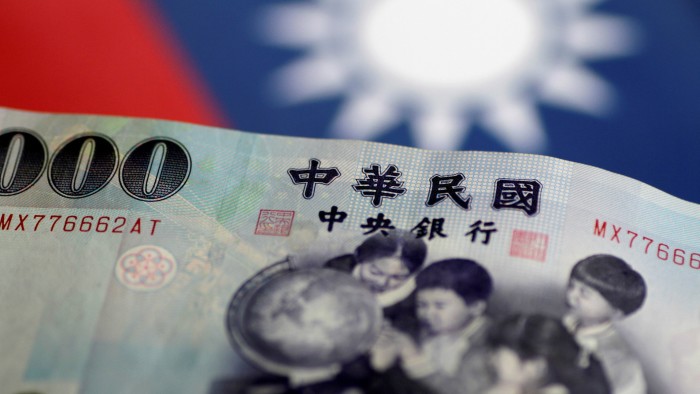Stay informed with free updates
Simply sign up to the Foreign exchange myFT Digest — delivered directly to your inbox.
Taiwan’s currency has recorded its largest two-day jump in decades, as life insurers moved to hedge their exposed US portfolios and markets fretted that a trade deal with Donald Trump might include the exchange rate.
Extending its gains when trading opened on Monday, the New Taiwan dollar rose another 2.5 per cent against the greenback, taking its two-day gain to 6.5 per cent. Its total rise since the start of April is almost 10 per cent.
The sudden currency movement in Taiwan shows how the impact of the US trade war is rippling through the global economy. It could harm the competitiveness of the island’s export-oriented economy and expose Taiwanese life insurers to losses through their holdings of US assets.
“Local exporters are panicking, and local lifers are under-hedged, while equity-related outflows have ceased,” said Ju Wang, a strategist at BNP Paribas in Hong Kong.
“The central bank remains the only buyer but has not been aggressively supporting the market, fuelling speculation that currency valuation is part of the trade talks,” she said.
Taiwan’s President Lai Ching-te tried to quell speculation that the US had asked for the currency to appreciate.
The country’s trade surplus with the US had nothing to do with the exchange rate and would “naturally not be mentioned in the negotiations between Taiwan and the United States”, Lai said in a video message provided to local media outlets on Monday.
Taiwan has a huge pile of overseas assets amounting to $1.7tn, much of it in US bonds — including Treasuries and corporate debt — held by its life insurers.
However, many of those insurers have not hedged their currency exposure, so they are exposed to losses when the US dollar falls. A rush to hedge those risks in a falling market might have exacerbated the currency’s move, said analysts.
The currency jump has been exacerbated by speculation that a possible trade deal with the US could include provisions to strengthen the Taiwanese currency and make it less competitive.
Taiwan’s central bank also reiterated that the US Treasury department had not requested the appreciation of the currency. It also described claims that US tariff negotiations could include requirements for currency appreciation as “speculation, not fact”.
BNP’s Wang was sceptical. “While no economy would officially acknowledge that currency valuation is a point of negotiation, market expectations indicate otherwise. This is particularly notable given the Mar-a-Lago [accord]’s emphasis on an overvalued US dollar being a root cause of the US’s trade imbalances.”
Driven by its globally competitive semiconductor sector, Taiwan is the seventh-largest US trading partner. In 2024, it had a trade surplus of $74bn with the US.
Stock in Taiwan Semiconductor Manufacturing Co, the world’s biggest contract semiconductor producer, fell 1.3 per cent on Monday. A weaker US dollar would hurt TSMC’s profits in local currency terms.
https://www.ft.com/content/aa5ba27f-89b1-4948-ad59-8c2f7f85af24


